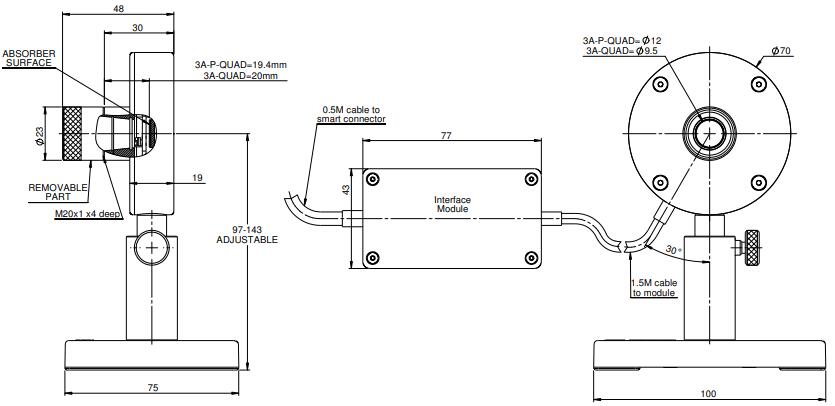Updated:2025-03-13
Views:1324
 WeChat
WeChat
 QQ
QQ
 Online Service
Online Service
The BeamTrack series 3A-P-QUAD laser measurement sensor measures laser beam position well as power and energy. It has a 12mm aperture and can measure beam position to 0.15mm accuracy. It measures power from 160µW to 3W and energy from 30µJ to 2J. It has the P type volume absorber that covers the spectral range from 0.15 to 8µm. The sensor comes with a 1.5m cable that connects it to the electronic box, and another 0.5m cable that connects the box to a Meter or PC interface.

| Absorber Type | P type |
| Aperture | Ø12mm |
| Spectral Range | 0.15-8µm |
| Power Range | 160µW-3W |
| Energy Range | 30µJ-2J |
| Dimensions | Ø70 W x 30 D (mm) |
| Max Pulse Energy | 2J |
| Max Average Power Density | 0.05kW/cm² |
| Response Time | 2.5 s |
| Max Energy Density (for <100ns) | 1J/cm² |
| Max Energy Density (for 2ms) | 1J/cm² |
| Max Average Power | 3W |
Can the BeamTrack sensor be used to measure the position and size of the pulsed laser?
Because position and size are measured together with power, if the laser pulses at a rate at which the average power can be measured, then position and size can also be measured.
Must a specific sensor be used only with the instrument used when ordering?
Ophir instruments and sensors are calibrated independently. Each instrument has the same sensitivity as the other instrument, and the error is about 2%. Each sensor is calibrated independently of a specific instrument, and its calibration information is contained in the DB15 plug. When the sensor is connected to the instrument, the instrument will read and interpret this information. Since the accuracy of the sensor is usually+/- 3%, the additional 0.2% error that may result from inserting different instruments can be ignored, so it does not matter which calibration instrument is used for a specific calibrated sensor.
What does it mean that the spectral range is beyond the calibrated wavelength range?
The spectral range described at the beginning of the specification represents the range of wavelengths that the sensor can effectively use, even if no precise calibration is specified for that range. This means that the accuracy is specified and guaranteed within the calibrated wavelength range. In a wider range of useful wavelengths, the sensor can be used but its accuracy cannot be guaranteed. Generally speaking, within this wider range, the accuracy will be within ± 15%.
Customer Service QQ
Customer Hotline:
Technical Supports